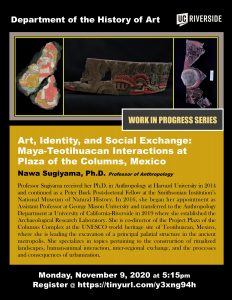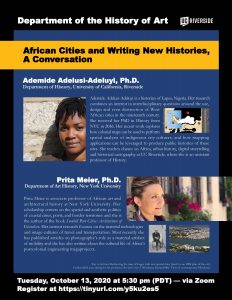Department of the History of Art – 2021 Work in Progress Series
GOOD TO THINK WITH: Rembrandt’s Aristotle with a Bust of Homer
Join us on Thursday, January 28, 2021 at 5:15 pm (PST) — via Zoom
Register at https://tinyurl.com/y4vgprbz
 Dr. Jeanette Kohl
Dr. Jeanette Kohl
Professor of Art History, UC Riverside
In this work-in-progress talk, art historian Jeanette Kohl will discuss the historical and ‘phenomenological’ significance of bust portraits as powerful objects of individual remembrance and intimate dialogue. She will do this through the lens of a painting: Rembrandt’s “Aristotle with a Bust of Homer,” one of the most celebrated works in the Metropolitan Museum of Art. An introductory chapter from her upcoming book “The Life of Busts. Sculpted Portraits in Fifteenth-Century Italy,” the study also presents a novel interpretation of Rembrandt’s enigmatic painting.

 Nawa Sugiyama, Ph.D.
Nawa Sugiyama, Ph.D.
 How did Indigenous Mexican communities experience the art and architecture of sixteenth-century missions? I situate monastic mural painting in the broader discourse of Indigenous sovereignty and local knowledge systems to displace the traditional narrative of European colonial hegemony that dominates the study of art and religious conversion. Through analysis of the relationship between murals, architecture, and their viewers, I argue Indigenous artists drew on their experiential knowledge of their land to structure new social and political relations through Christian art. This new account of colonial Mexican art thus challenges modern notions of the Mexican missions as primarily places for religious conversion and European colonization.
How did Indigenous Mexican communities experience the art and architecture of sixteenth-century missions? I situate monastic mural painting in the broader discourse of Indigenous sovereignty and local knowledge systems to displace the traditional narrative of European colonial hegemony that dominates the study of art and religious conversion. Through analysis of the relationship between murals, architecture, and their viewers, I argue Indigenous artists drew on their experiential knowledge of their land to structure new social and political relations through Christian art. This new account of colonial Mexican art thus challenges modern notions of the Mexican missions as primarily places for religious conversion and European colonization.